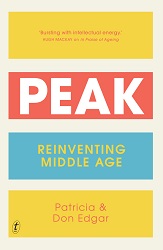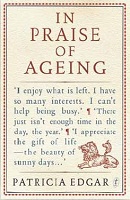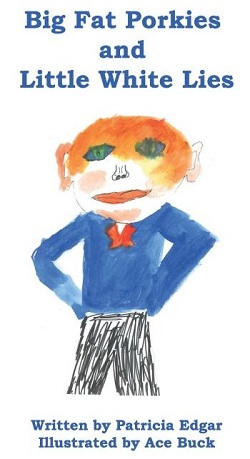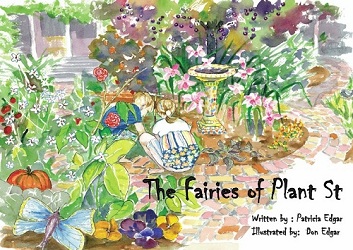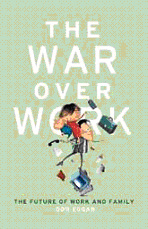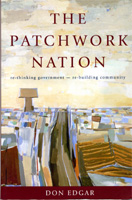Loving and working in a changing world
Don Edgar
Address to Australian Federal Police Workshop, Canberra, 28 October, 2009
View powerpoint presentation (requires MS Powerpoint 2007 or higher) 
Sigmund Freud is said to have made the comment that “Love and work are the cornerstones of our humanness.” Or, in other versions, “Love and work … work and love, that’s all there is.” In his writings, the terms “Lieben und arbeiter” do feature as issues round which full maturity develops. But it was actually Erik Erikson who said it first, in his 1950 book ‘Childhood and Society’ – and his point was that in the risky game of life, every individual needs to develop the capacity for productive work and the capacity for good, personal, sexual relationships as an adult.
Children have to develop the capacities necessary for survival through productive work and the capacities needed to sustain meaningful human, loving relationships. And they do that – or fail to do that – through their interactions with parents and other adults. For the New Child, both tasks seem to be becoming increasingly difficult.
If you think in these terms about the difficulties today’s adults have in balancing work and family responsibilities, you have a way in to understanding how dramatic are the changes we face. Both the nature of productive work and the nature of family (as a surrogate for loving relationships) have shifted markedly. And those of us who have responsibilities for employing and managing others will need to think laterally if we are to cope with the challenges humanity faces.
First, the changing nature of loving relationships. Families are always changing, but some trends make for serious worries.
- By 2026 Australia will have more households, but not just families. Yet it is families, not households, that make for community life as we know it.
- More of us will live alone. While the number of Australian households will grow from 7.4 million now to 10.8 million in 2026, lone-person households show the biggest increase, from 1.8 million in 2001 to over 3 million by 2026.
- Queensland and Western Australia single person households are increasing faster than other states, but Victoria alone will have another 400,000 dwellings with one person living alone.
- Many will be older people (especially women) living alone, so dealing with loneliness and care of the aged will be increasing problems for those of working age. Already, some 34% of those aged 75 and over are living alone, 40% with a partner and 13% are in a non-private dwelling. The figures will grow markedly as the population ages. These old people don’t want to live in modern apartments, or aged care ghettoes; they prefer to live near their familiar shopping centres, local doctors and friends, so urban planning faces a real challenge in providing acceptable accommodation for them.
- Many of these single person households however are not the oldies. They comprise what I call ‘The Solos’, young singles working hard, playing hard, spending their income freely on dining out, drinking, drugs and partying, forging ‘loving relationships’ with other singles, but in serial, non-committed ways that increasingly do not lead to living together or marriage. As they age, the search for a mature, ongoing relationship becomes harder so alienation, depression and desperation increase.
- Couples with children are a decreasing proportion of our population. There are 1.5 million such families now, just 28% of all ‘families’, plus 360,000 lone parent families with children, whose relative poverty remains a problem for the future of children.
- Despite this decline, the younger Solos resent the work-family benefits they see as companies giving favors to ‘family’ employees, and calls for work-family balance become confused with demands for work-life balance, a completely different thing. They want job flexibility so they can play golf, or do extra study, or travel, not because they have unavoidable obligations that must be met to others. The fact that they will have responsibilities for ageing parents further down the track is not on their horizon yet, and there is a backlash against hard-won work-family benefits that need to be protected.
- For working families with children, life is getting tougher. Job insecurity, the rapidity of technological change and outdated job skills cause anxiety and job stress.
- Of those with children, 62% have both parents working outside the home, 60% of them with one and a half jobs, and 95% of mothers choosing (of necessity and preference) part-time jobs that pay less and offer fewer benefits.
- The work-family balance, despite political and business rhetoric, has become more difficult. Half of these employed parents work variable hours on call. 60% do some night work, over half work some weekends, only a third have access to paid carer’s leave and only a quarter have paid maternity leave. Two-thirds are entitled to holiday and sick leave, and 70% work long extra hours, only 12% of which is paid.
- Demands for increased productivity have increased what is called work intensity, and in hard economic times, keeping up to the mark is an imperative for all. The average hours worked for fathers is 50 hours, for mothers 24.
- So 82% of employed couples with children under 15 report feeling ‘rushed or hurried’, the reasons given being the difficulty of juggling work and family, the real-time demands of family life and simply having ‘too many demands’ on their time.
- As well, there are 2.5 million people who are care-givers for the old and sick or disabled. Such caring responsibilities prevent many from working themselves, or working full-time, and more carers than others felt ‘rushed’ in day to day life.
My point is that it has become more difficult both to work productively (and feel some satisfaction from that work) and to achieve satisfying adult relationships. Time is of the essence and marital relationships take time to maintain. Parenting in particular becomes more difficult.
We see the social effects of such a trend in the rise of small apartments not designed for cooking or eating, restaurants, more cafes and bars which serve as social and sexual meeting places for the young singles, growing misuse of drugs and alcohol which must affect work performance, and a decline in the now old-fashioned idea of loyalty to the firm. The Solos are seeking personal growth, gratification, positive feedback, and an understanding from their bosses that for them work is just a means to an end - enjoyment and pleasure - not a permanent buffer against family poverty or meeting their caring obligations to others.
Worse, perhaps, today’s children have less time devoted to them by parents able to forge loving relationships with them and spend more time in transient interaction with various non-family carers, teachers, specialist activities outside the home. This may be the perfect breeding ground for future single, unattached, uncommitted workers who can put their love lives on hold, or transform their love lives into a series of fleeting and uncertain sexual relationships that will fit round the increasing demands of work. But for me, it does not augur well for the future cohesion of society.
Indeed, the mantra of self-exploration, happiness, self-esteem and personal growth has swamped the notions of self-sacrifice, delay of gratification, reciprocity with others in the community and working with others towards the common good. What is more, the philosophy of self now permeates the media so much it has created a raunch culture of adventure, risk, sleaze and indifference to the sufferings of others which is infecting the values and attitudes of children and youth. It manifests itself in programs progressively targeting teens, tweens, young children, infants and even babies, with products marketed to them as the new and future consumers whose only concern is to buy the latest gadget, the latest sexy clothes, not to focus on real self-growth through work and deep human relationships.
Some writers also point to a growing divide between those children whose parents set limits on behavior, encourage curiosity, value education and hard work so children come to understand the world around them, and those who live a more shallow life based on apeing their peers, expressing a phony individuality through mass-marketed products and copy-cat behavior, not being exposed to quality schooling or consistent and socially-oriented parental values, and are thus condemned to a conforming mediocrity that leads to neither a productive work life nor an adult ability to love and nurture other people.
Howard Gardner, the Harvard University psychologist who challenged thinking about IQ tests by showing there are ‘multiple intelligences’ says the most crucial abilities, what he calls ‘5 Minds for the Future’ are –
- A disciplined mind – knowing how to work hard and steadily over time to improve skill and understanding, plus having real expertise in at least one discipline or area (at least ten years work to master)
- A synthesizing mind – to evaluate what ‘information’ is sound and relevant to the task at hand, and put it together in ways that make sense
- A creating mind – can ask unusual questions and develop unexpected answers, can think ahead, find new ways of doing things, not depend on old accepted routines and ideas
- A respectful mind – necessary in the modern world because we are so inter-connected; not necessarily agree but understand ‘others’ and work effectively with them
- An ethical mind – one that goes beyond self-interest and can work unselfishly to improve the lot of all, see your own goals in light of the broader society and the common good
In other words, no genuine integrity of self, no genuine creativity or meaningful productivity, no worthwhile community respect and valuing of others can come if society does not encourage in its children the values and capacities of hard work, discipline, making links, being respectful of others and working for the common good. But we have to ask, how well are our schools, parents and the media laying the groundwork for such minds, such abilities to work and love?
It was Howard Gardner too whose work led to the current groundswell of interest in ‘Emotional Intelligence’, in Gardner’s original terms a combination of intra- and inter-personal intelligences. If a child is not encouraged to think about and manage its own feelings, to get a grip on self-control and why you sometimes feel sad, angry, happy or shocked, they will never be able to act intelligently for themselves; equally, if a child fails to develop an interest in and respect for others, cannot put themselves in their place and feel empathy for someone who is upset or joyous, they will be unable to interact sensibly with other people. Together, these two forms of intelligence make up what Daniel Goleman later called Emotional Intelligence.
If you think about it for a minute, a child or adult who has no self-insight and no empathy with others is unlikely to be successful in forming any sort of loving or working relationship with others, they will fail in both love and work, will not have the capacity to explore their full humanness, to be part of the wider community of respectful social relationships.
That is why it’s so important to teach children to respect others, to observe and listen before jumping to conclusions, to try and understand where they are coming from, why they think the way they do, in order to be able to interact in a fruitful way with them, despite what may be wide cultural value differences. The latest research on brain reactions to situations that threaten us seems to indicate that we learn our prejudices, they get inbuilt through the typical reactions and thought processes of our culture. And they can be unlearned, given the right sort of learning interventions.
Yet we are in danger of increasing prejudice in Australia, based on a shift away from our traditionally tolerant acceptance of nationalities, races and ethnic groups of immigrants. We have come a long way from the days of White Australia, distrust of Asiatics, the yellow hordes threatening to overrun a small European society in the Antipodes. But the signs are emerging that we face a danger similar to that of Great Britain and the rest of Europe where large numbers of migrants cluster in disadvantaged ghettoes, excluded from better jobs and incomes, allowed to congregate in defensive communities as racial prejudice is stirred up because they are unfair competition for the traditional whites.
Together, India and China make up 38% of the world’s population, 62% of Asia’s population. Under our Skilled Migrant intake, there has been a six-fold increase in Chinese over the past decade and a four-fold increase in Indian migrants. Most of them are recent arrivals. By 2008 some 310,000 were Chinese, 240,000 from India. So it’s not surprising, given the recent economic crisis, that Australian-born and European-origin citizens see the emerging power bases of China and India as a threat. Or that there is strong support for a tough stance by government on illegal, refugee-style immigrants jumping the queue.
In Australia it works differently, so far, from what has happened in Europe. It is the better educated, better off Indians and Chinese who seem to threaten white jobs, though they are here precisely because not enough of our current population has the skills needed.
Unfortunately public opinion is ill-informed and racist attacks are interpreted as endemic. Partly this is because they cluster in the main cities, 90% living in Sydney or Melbourne, more Chinese in Sydney, more Indians in Melbourne. But they are not just young single students. In fact, 43% of the Indian-born are couple families with children, so are 38% of the Chinese. While 28% of Australian-born are couples with no children, 22% of Chinese and 24% of Indians are couples with no children. So the stereotype of single students living in group homes is incorrect. Overall only 13% of the Chinese and 11% of Indians live in what we call group homes; the figures are higher (34-35%) if they are still students and do live together in group homes.
Skilled migrants have three times more higher degrees compared with Australian-born, mostly in management, commerce, engineering and technology. In the IT industry alone, 11% of all employees are Chinese, 14% Indian and only 3% Australian-born.
But this hides another ongoing trend that makes for a more unequal society in the future. The poorer groups of immigrants, from African countries, from war zones such as the Sudan, Ethiopia, Lebanon, Iraq, Sri Lanka, Afghanistan tend to cluster in certain suburbs, the outer west where housing is cheaper but jobs harder to get, and both their education level and language skills are poorer than the Chinese and Indians. So we see houses being bought in more affluent suburbs where schools are better by the Chinese, Koreans and Indians, while poorer suburbs take on a dominant non-white, non-English-speaking complexion bound to cause racial and economic tensions. This growing lack of ethnic integration and increasing income divide will split our big cities unless deliberate planning and placement take place. The ethnic mix in some suburbs is volatile: Cabramatta for example 133 nationalities and 70 languages, with 31% born in Vietnam and 28% born in Australia. Springvale in Melbourne’s outer east comprises 21% Vietnamese, 29% Catholic and 29% Buddhist.
We can see a parallel social divide increasing in our schools. Private schools now comprise 28.5% of all schools, State schools are now down to 71.5%. Despite the Rudd Government’s touted Education Revolution and school building stimulus program, parents are voting with their feet because they know their children are more likely to gain the skills needed for success in both love and work in private schools where values – even though they may not be religious values they espouse themselves – are inculcated and an ethic of hard work, achievement-orientation and valuing the whole process of education. It is only there (and in the best of the State schools) where children can develop an authentic sense of self, based on real abilities, real discipline in both an academic and a behavioral sense, a wider view of the world and its problems plus the links between their own actions and the common good.
Interestingly, Australia is now implementing the AEDI, our equivalent of the Canadian Early Development Index, and it is showing how unequal are the life chances of children from different regions and suburbs. It will be used to assist prep teachers’ work with new school entrants, along with (in Victoria) Transition Plans written by kindergarten, child care workers and parents to suggest what strengths and weaknesses starting students have. The AEDI measures five capacities which are considered essential for effective learning and development:
- Physical health & wellbeing, including motor skills, energy and daily living skills
- Social competence, curiosity, cooperation, respect for others, knowing the rules
- Emotional maturity, such as empathy and self-control
- Language & cognitive skills, including reading awareness, game-playing, memory
- Communication skills & general knowledge, the ability to tell stories, communicate their needs, understand the symbolic use of language
The trick will be to train teachers to look for such developmental signposts and work with each child to improve on such abilities, rather than simply to apply a rigid curriculum framework or, worse, to label some children as defective and relegate them to less rigorous classroom work.
In short, Australia faces a challenging future in which both economic and social problems will rise to question the prevailing ego-centric, individualistic culture we have allowed to dominate in Australian schools and workplaces. My point is that we need to cultivate in our children and in our workplaces a more authentic individualism, one based on respect for others, taking responsibility for more than our own wellbeing, an ethical frame of mind which would make both working and loving - workplace and private emotional relationships – more productive.



